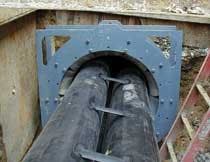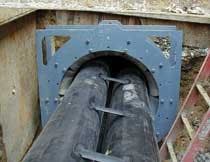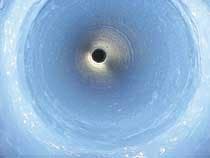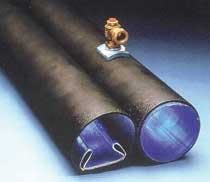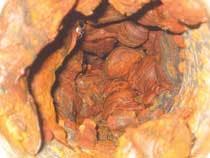by Gerhard P. Muenchmeyer
The water main infrastructure in the U.S has reached an age where putting off repair or renewal is no longer an option. The EPA has estimated some $374 billion over 20 years or about $18 billion a year beginning in 2002 should be spent on potable water main renewal. Actual spending is closer to $1.1 billion per year. The good news is that annual spending for water main renewal is growing at about 25% which is significantly higher than current spending on sewer pipeline renewal. It is expected that this growth will continue for the immediate future.
Over the last 25-30 years the development of trenchless technologies has primarily focused on the sewer pipeline renewal industry. EPA consent orders and excess surface water pollution from pipe overflows have driven this development. Potable water mains are typically not buried as deep in the ground, can be installed on varying grades and operate under pressure. Therefore, simple excavation and replacement can be as cost-effective as trenchless methods, in some cases. However, many choices for trenchless renewal technologies exist today for water mains and more are being developed.
Water Main Issues
Water main problems can generally be defined under four categories: Tuberculation; faulty or deteriorated joints; inadequate hydraulic capacity; and internal and/or external corrosion.
Over time, internal corrosion and tuberculation of cast iron and ductile iron mains lead to poor water quality, inadequate flow capacity or loss of pressure.
Faulty or deteriorated joints are also a common problem. The pipe material typically holds up better over time than the materials used to seal the joints. Pinholes, caused by internal or external corrosion will, in time, cause the main to leak and subsequently fail.
Lack of sufficient hydraulic capacity is another problem impacting water mains. With the extensive growth experienced in many parts of the country, older mains, in some cases, do not have sufficient hydraulic capacity to service the new customers and need to be replaced with a larger pipe.
Renewal versus Replacement
Trenchless technologies for water main repair and replacement fall into three general categories: non-structural coatings, structural and non-structural linings, and replacement systems.
Non-structural coating renewal of mains usually solves such issues as water quality, very low maintenance incidents and reduced hydraulic capacity. Structural or non-structural lining renewal of mains will solve such problems as periodic breaks, high maintenance and repair, and major hydraulic capacity loss. Replacement technologies can solve increased capacity needs, exterior pipe corrosion, existing pipe material replacement and surface restoration considerations.
Common Solutions
Technologies for water main repair or replacement must be designed to go around bends and be structurally capable of sustaining high operation pressure variations as well as external loading conditions. Most important however is that each technology used in water main renewal must be tested and listed for potable water applications.
The renewal technologies discussed below represent a sampling of what is available to the water industry.
Non-Structural Coatings
Non-structural coatings have a long history in water main renewal. Cement mortar lining has been used for smaller diameter mains, gunite for larger mains and tunnels, and more recently polymer products have been effectively used in the renewal of water mains. No service tap reinstatement is required and main capacity loss is minimal.
These methods improve water quality while extending the life of the pipe asset, but do not add any significant structural strength to the existing main. The non-structural materials will span over pin-holes and minor defects in the pipe and provide long term protection for the existing main.
Another non-structural water main technology, used primarily for stopping leakage through a pipe joint, is the internal seal. The internal seal has been used to stop leaks in water mains for over 30 years. This technology is applicable to pipes 16" and larger and requires man entry to install the seals in the pipeline. Materials include EPDM rubber and stainless steel compression rings approved for potable water applications.
Structural and Non-Structural Linings
Non-structural lining technologies include a number of systems specifically developed for water main and pressure pipe renewal.
Folded HDPE hose lining, after installation, has a stand-alone internal pressure rating of 150 psi. This technology is intended for water main renewal up to eight inches in diameter and will provide a smooth internal surface, improve water quality and protect the existing main from further internal corrosion. Service taps are typically excavated and reconnected directly to the installed liner. New technology is being developed for the reconnection of water main taps by robotic means from inside of the new liner, thereby eliminating some excavations in the future. The hose lining technology has been successfully installed in water mains for a number of years in the U.S.
Cured-in-place pipe lining has been developed for water mains up to 10 inches in diameter using a potable-water-approved epoxy resin system. The system seals leaking joints, pin-holes and small non-structural cracks. Typically a pressure end seal is installed at the ends of the liner to prevent material flow between the new liner and the existing host pipe. The system fits tight within the host pipe and service taps are reconnected robotically from the interior of the installed liner pipe.
A number of HDPE pipe systems have been developed over the years for water and pressure pipe applications. These generally include folded, roller reduced and Swaged.
The folded HDPE technology is produced in a “U” or “C” shape and when installed will fit tightly against the wall of the host pipe. This technology can be installed in pipelines up to 48 inches in diameter. The HDPE material can be designed for both structural and non-structural applications and provides a proven material solution for improved hydraulics and water quality. Service taps are typically excavated and connected to the new pipe. However, with the development of robotic technology internal tap reconnection may become a reality in the future.
Roller reduction mechanically reduces the outside diameter of the HDPE pipe so that it can effectively be pulled into a host pipe. The pipe is systematically reduced in size by circumferentially spaced rollers, usually a set of three, each of which are sequentially reduced in diameter spacing. The material is pulled through the roller assembly and can be installed in pipelines from 2 inches up to 48 inches in diameter. Couplings are then used to reconnect to the exiting piping system. The installed pipe provides improved hydraulics and water quality. This technology has been installed since the early 1980s and lengths of up to 5000 feet have been accomplished.
Swagelining has been used for a number of years. Similar to roller reduction the HDPE is reduced by being pulled through a reduction die and then quickly installed into a host pipe ranging from 3 inches to 42 inches in diameter. The installed product improves system hydraulics and water quality and can be structural or non-structural in design with wall thicknesses from SDR 17 to SDR 42. Average pulls of 1000 ft. to 1200 ft. have been successfully accomplished for a variety of pipe applications.
Replacement Technologies
Total main replacement using trenchless technologies is another option available to the water industry. In some cases the water utility requires an increase in the size of the existing main or the main may require replacement for structural reasons. Several technologies including pipe sliplining, pipe bursting and directional drilling may offer the required solution for the water system operator.
Sliplining has been a traditional method for water main renewal and replacement for many years. The common method has been to install a smaller size, fused, continuous length, HDPE pipe from excavation point to excavation point; then reconnecting the pipe with couplings as applicable. Typically the installed pipe is smaller in diameter but with the smoother friction factor of the new pipe the capacity of the system is not reduced significantly. The recent introduction of fused PVC pipe has given system operators and additional choice for slip lining water mains.
Pipe splitting and bursting has made significant inroads into the water main replacement market, with a variety of pipe replacement materials and installation methods developed. Using this technology, the existing pipe is ether cracked and expanded or split and expanded, depending on the material of the old water main, and a new pipe is installed inside the old pipe.
Pipe material currently used with the pipe bursting technology for water main renewal includes fused HDPE in a variety of wall thicknesses, PVC both with fused or locking joints and ductile iron restrained joint pipe. A significant advantage of this technology is the ability to install a new pipe which is larger than the old water main.
Horizontal directional drilling is used to install a pipeline in a new location rather than lining or replacing the existing pipe in place. A larger replacement pipe can be installed, using a variety of materials similar to those used in pipe bursting. The new installation will provide better hydraulics and improved water quality and is designed for a full structural pipe. It is typically used to install pipes in sizes ranging from 6 inch to 24 inch in diameter even though larger installations have been successfully accomplished. Excavation is typically required to reconnect the house service taps from the old existing main to the newly installed main. If the locations of the old pipe and the new pipe are spaced far apart then significant excavation may be required.
Limiting Factors
While these new technologies are effective, water main renewal in itself presents several limiting factors.
Traditionally when a water system is renewed a temporary water supply system must be installed to serve the affected homes or businesses, must be pressure tested, disinfected and be maintained for the duration of the renewal program. The cost of this temporary water bypass system must be taken into account when considering a renewal technology. This cost is common to all technologies.
In several areas of the country, test projects have been performed using pre-chlorinated pipe materials. The use of pre-chlorinated pipe essentially eliminates the need for a bypass system but is typically limited to small sections of water main that can be returned back to service within a day. Bottled water can be supplied to the affected homeowners for the day to minimize any inconveniences.
Many renewal technologies require that the service taps be excavated and reconnected to the newly installed product. The cost of excavation, the disruption and the cost of asphalt restoration make this another consideration when evaluating the use of renewal techniques.
The development of robots to reconnect the service from the inside of the newly installed pipe should reduce costs and increase the use of many of these technologies.
Summary
The demand for water main renewal will increase in the near future. As water system managers gain a greater awareness of the poor condition of their water infrastructure, the demand for existing and new technologies will increase significantly. As these managers become more aware of a wider selection of the tools systems available, and develop a higher confidence level from their successful installations, the use of renewal technologies will increase in the water industry.
As newer and more cost effective robotic support equipment is developed, increasing production and lowering costs, the water system operator will begin to have a higher confidence level and further accelerate the growth of these technologies.
About the Author:
Gerhard “Gerry” P. Muenchmeyer, P.E.. is Technical Director for NASSCO and principal of Muenchmeyer Associates LLC, Trenchless Technology Consultants. He is a Registered Civil Engineer with over 45 years of experience in water, wastewater and trenchless technology development, design and construction. Muenchmeyer was a founding member of the International Pipe Bursting Association and founding member of the NASSCO Pipeline Assessment & Certification Program (PACP).
